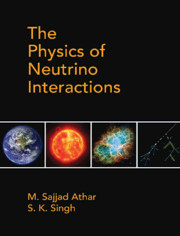Book contents
- Frontmatter
- Dedication
- Contents
- List of Figures
- List of Tables
- Preface
- Acknowledgments
- Chapter 1 Neutrino Properties and Its Interactions
- Chapter 2 Relativistic Particles and Neutrinos
- Chapter 3 Quantization of Free Particle Fields
- Chapter 4 Interacting Fields and Relativistic Perturbation Theory
- Chapter 5 Phenomenological Theory I: Nuclear β-decays and Weak Interaction of Leptons
- Chapter 6 Phenomenological Theory II: Weak Decays of Hadrons
- Chapter 7 Gauge Field Theories and Fundamental Interactions
- Chapter 8 Unified Theory of Electroweak Interactions
- Chapter 9 Neutrino and Electron Scattering from Point Particles
- Chapter 10 Neutrino scattering Cross Sections from Hadrons: Quasielastic Scattering
- Chapter 11 Neutrino Scattering from Hadrons: Inelastic Scattering (I)
- Chapter 12 Neutrino Scattering from Hadrons: Inelastic Scattering (II)
- Chapter 13 Neutrino Scattering from Hadrons: Deep Inelastic Scattering
- Chapter 14 Weak Quasielastic v(⊽)-nucleus Scattering
- Chapter 15 Inelastic Scattering of (Anti)neutrinos from Nuclei
- Chapter 16 Deep Inelastic Scattering of (Anti)neutrinos from Nuclei
- Chapter 17 Neutrino Sources and Detection of Neutrinos
- Chapter 18 Neutrino Mixing and Oscillations
- Chapter 19 Neutrino Astrophysics and the Synthesis of Elements
- Chapter 20 Neutrino Interactions Beyond the Standard Model
- Appendices
- Appendix A Lorentz Transformation and Covariance of the Dirac Equation
- Appendix B Cabibbo Theory
- Appendix C Some Properties of Pauli and Dirac Matrices and Spin Density Matrices
- Appendix D Leptonic and Hadronic Tensors
- Appendix E General Expression for the Total Scattering Cross Section and Decay Rates
- Appendix F Expressions of N(q2), the Coefficients of the Polarization Observables
- References
- Index
Chapter 9 - Neutrino and Electron Scattering from Point Particles
Published online by Cambridge University Press: 22 May 2020
- Frontmatter
- Dedication
- Contents
- List of Figures
- List of Tables
- Preface
- Acknowledgments
- Chapter 1 Neutrino Properties and Its Interactions
- Chapter 2 Relativistic Particles and Neutrinos
- Chapter 3 Quantization of Free Particle Fields
- Chapter 4 Interacting Fields and Relativistic Perturbation Theory
- Chapter 5 Phenomenological Theory I: Nuclear β-decays and Weak Interaction of Leptons
- Chapter 6 Phenomenological Theory II: Weak Decays of Hadrons
- Chapter 7 Gauge Field Theories and Fundamental Interactions
- Chapter 8 Unified Theory of Electroweak Interactions
- Chapter 9 Neutrino and Electron Scattering from Point Particles
- Chapter 10 Neutrino scattering Cross Sections from Hadrons: Quasielastic Scattering
- Chapter 11 Neutrino Scattering from Hadrons: Inelastic Scattering (I)
- Chapter 12 Neutrino Scattering from Hadrons: Inelastic Scattering (II)
- Chapter 13 Neutrino Scattering from Hadrons: Deep Inelastic Scattering
- Chapter 14 Weak Quasielastic v(⊽)-nucleus Scattering
- Chapter 15 Inelastic Scattering of (Anti)neutrinos from Nuclei
- Chapter 16 Deep Inelastic Scattering of (Anti)neutrinos from Nuclei
- Chapter 17 Neutrino Sources and Detection of Neutrinos
- Chapter 18 Neutrino Mixing and Oscillations
- Chapter 19 Neutrino Astrophysics and the Synthesis of Elements
- Chapter 20 Neutrino Interactions Beyond the Standard Model
- Appendices
- Appendix A Lorentz Transformation and Covariance of the Dirac Equation
- Appendix B Cabibbo Theory
- Appendix C Some Properties of Pauli and Dirac Matrices and Spin Density Matrices
- Appendix D Leptonic and Hadronic Tensors
- Appendix E General Expression for the Total Scattering Cross Section and Decay Rates
- Appendix F Expressions of N(q2), the Coefficients of the Polarization Observables
- References
- Index
Summary
Introduction
We have seen in Chapter 8, that the standard model for the leptons developedby Salam [37] and Weinberg [157], which was later extended to the quarksector by Glashow [64], unifies weak and electromagnetic interactions. Itpredicts, in a unique way, the interaction Lagrangian for charge changing(CC) weak interactions of leptons and neutrinos of all flavors with chargedgauge vector bosons, W± and theelectromagnetic interactions of charged leptons with photons. It alsopredicts the existence of neutral current(NC) weak interactions of chargedleptons and neutrinos of all flavors with the neutral gauge boson,Z0. The strength of the interaction of thecharged, neutral, and electromagnetic currents with theW±,Z0, and A gauge bosons aredescribed in terms of the weak coupling constants g,electromagnetic coupling constant e, and a free parameterθW called the weak mixing angle.Specifically, the interaction Lagrangian discussed in Chapter 8 is writtenhere again as:
where Zμ, andAμ are the charged, neutral andelectromagnetic gauge fields and
with is the fine structure constant. In the following sections, we use theinteraction Lagrangian in Eq. (9.1) to calculate the cross sections for someweak and electromagnetic processes using point particles, that is, chargedleptons and neutrinos.
Scattering
This scattering process can take place through an electromagnetic processmediated by a virtual photon as well as by the weak neutral current mediatedby a Z0 boson in the standard model [400].
When an electron interacts with a photon field (Figure 9.1(a)), theinteraction Lagrangian is given by:
and when it interacts with the Z0 boson field (Figure 9.2(a)), theLagrangian is given by:
Using the aforementioned Lagrangians corresponding to Figure and followingthe Feynman rules the transition amplitude for the process
mediated through virtual photon exchange of momentum in the lowest order, maybe written as:
and for the process mediated through the virtual Z0 exchange,shown by the Feynman diagram in Figure 9.2(b) as:
where. The process proceeding through Z0 is highly suppressed ascompared to the photon exchange therefore, in the present case, we presentthe cross section for the process given in Eq. (9.7) mediating through-exchange.
- Type
- Chapter
- Information
- The Physics of Neutrino Interactions , pp. 362 - 384Publisher: Cambridge University PressPrint publication year: 2020

